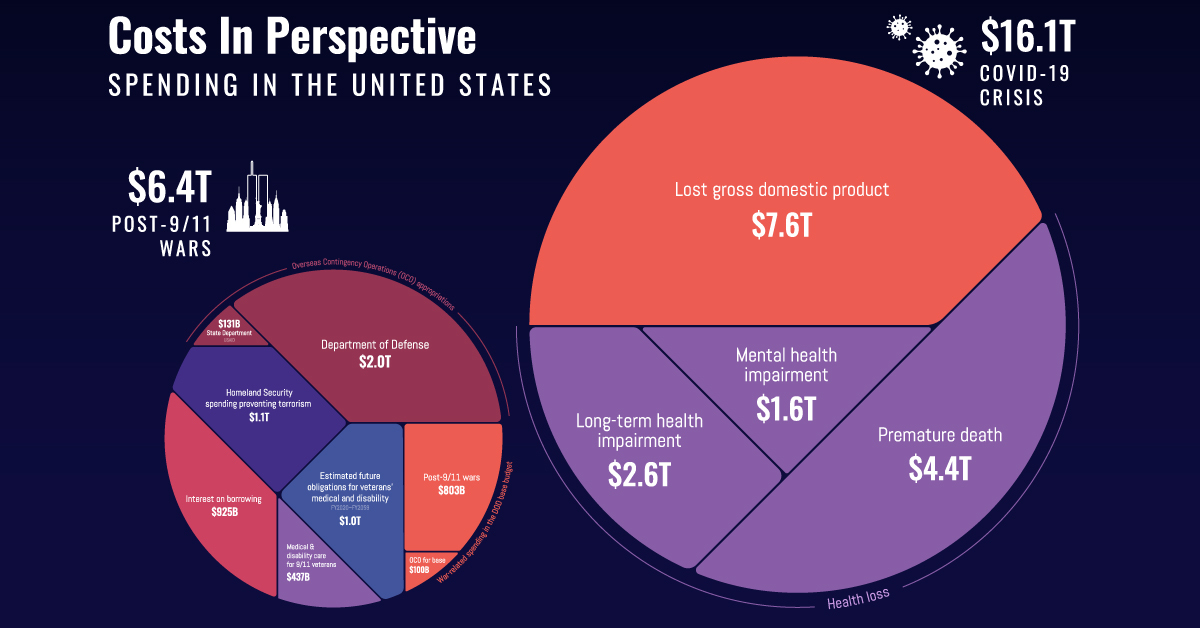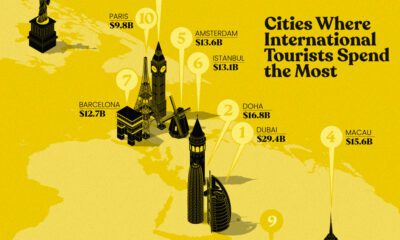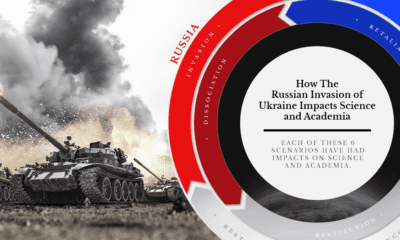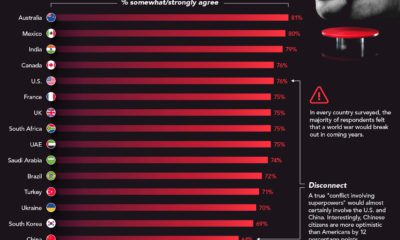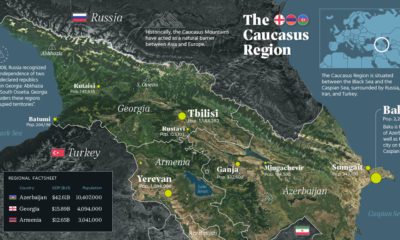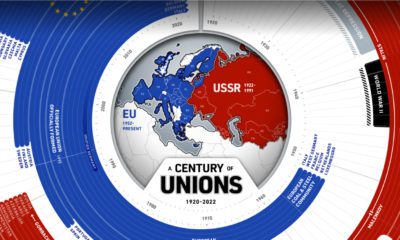Politics
Putting the Cost of COVID-19 in Perspective
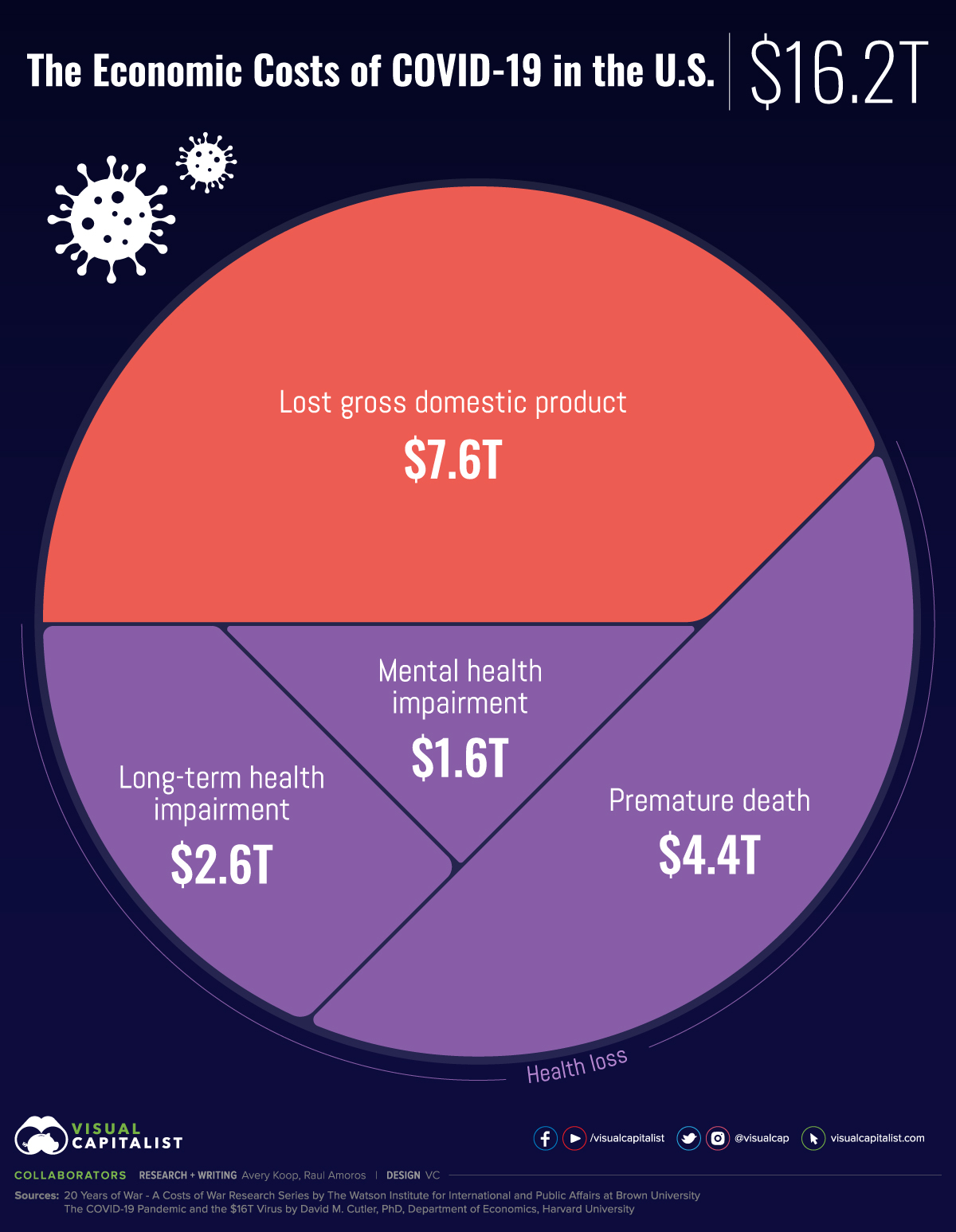
Putting the Economic Cost of COVID-19 in Perspective
When it comes to the toll on human life, mental well-being, and any long-term complications, the true cost of COVID-19 can be difficult to quantify.
That said, from a purely economic angle, researchers can and do examine these things—as well as economic data like unemployment and lost GDP, to assign dollar figures to the pandemic.
Using data from a study out of Harvard University, these visualizations focus on putting the economic cost of COVID-19 in the U.S. in perspective. To help us understand the immense price associated with a pandemic, the study looked at other comparables like the costs of running America’s longstanding war on terror.
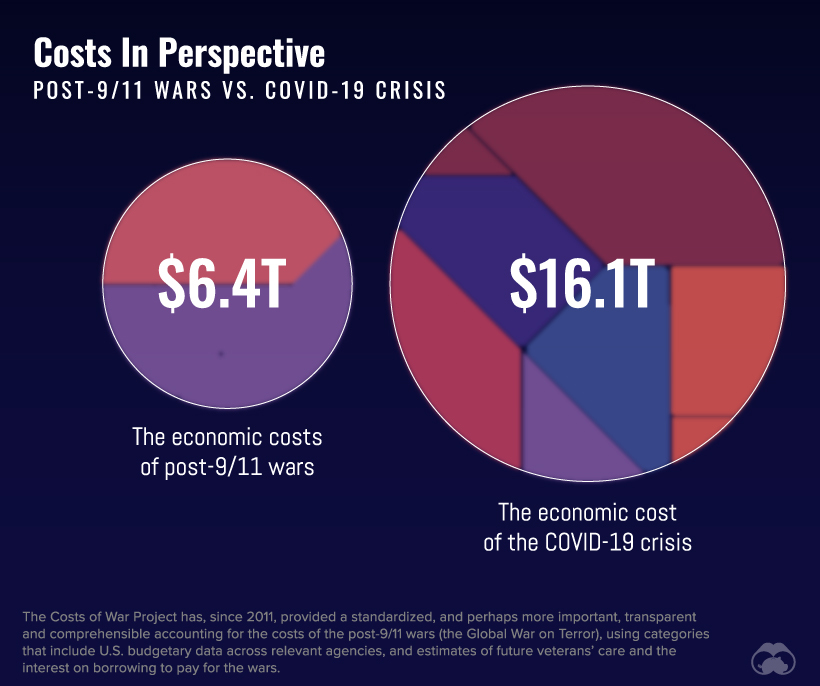
The Cost of COVID-19
Since the pandemic took hold in the U.S. in March 2020, job loss has been one of the most significant consequences. Unemployment claims in the U.S. have recently reached a total of 60 million, while lost GDP is estimated to be around $7.6 trillion.
Unemployment, uncertainty, lost loved ones, and lost social connections, have led to spikes in depression and anxiety. In April 2020, around 40% of U.S. adults reported having at least one of these mental illnesses. Based on the sheer number of people struggling, the cost of mental health impairment could be as high as $1.6 trillion, according to these researchers.
| Category | Cost (Billions) |
|---|---|
| Lost Gross Domestic Product (GDP) | $7,592 |
| Premature Death | $4,375 |
| Long-Term Health Impairment | $2,572 |
| Mental Health Impairment | $1,581 |
| Total | $16,120 |
The economic value of a human life can be put in terms of ‘statistical lives’, a notion used in both American and global health policy. While human life is priceless, the value tied to one using this metric sits between $7-$10 million. Even when using the lower end of the scale, the cost of premature death due to COVID-19 is estimated to be $4.4 trillion.
Finally, when looking at the long-term healthcare costs that could impact people who contract COVID-19, the price comes out to almost $2.6 trillion. These costs will go on for decades as certain lifelong conditions can emerge out of COVID-19, like respiratory and cardiovascular issues.
Many of these conditions could also end up causing premature deaths, drawing out the total cost of COVID-19 even further.
The Cost of War
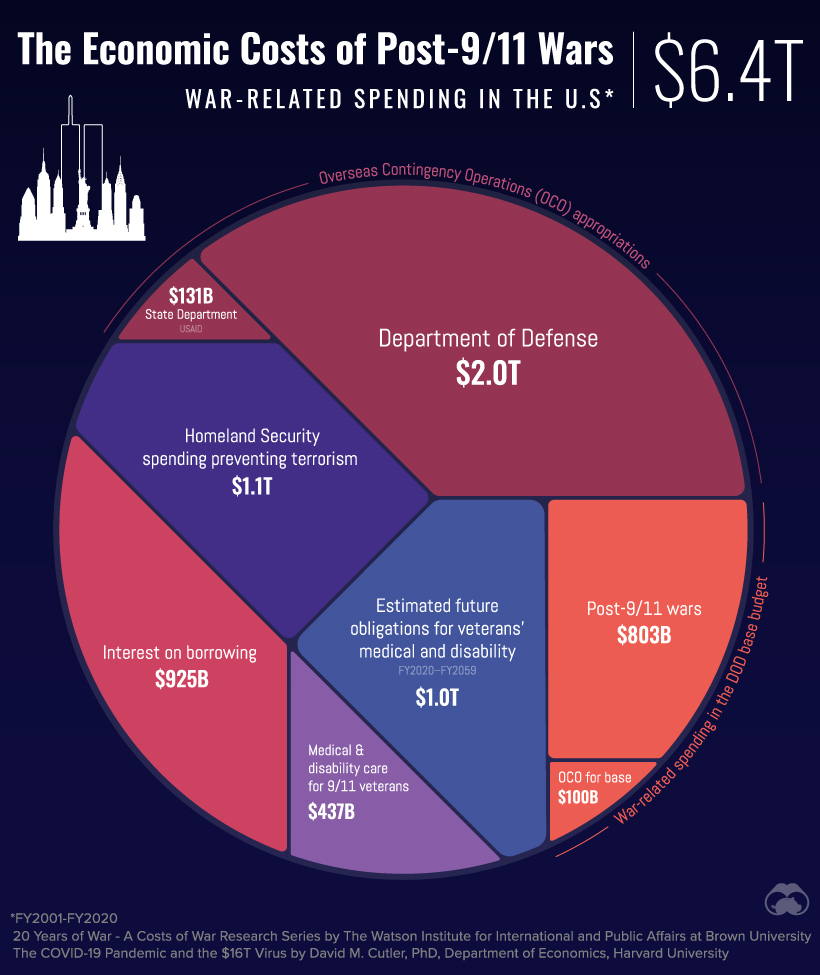
Both a global pandemic and a war have long-term health consequences and are extremely pricey.
The estimated cost of the post-9/11 wars rises to over $6 trillion. This is measured by the spending of the Department of Defense, the Department of State, and USAID. The estimate also takes into consideration current and future spending on medical and disability care for veterans, the cost of war appropriations and spending, the estimated interest on borrowing for different departments, and the spending the Department of Homeland Security has done in order to prevent and respond to terrorism.
| Category | Cost (Billions) |
|---|---|
| Department of Defense | $1,959 |
| State Department/USAID | $131 |
| Estimated Interest on Borrowing for DOD and State Dept OCO Spending | $925 |
| Estimated Increases to DOD Base Budget Due to Post-9-11 Wars | $803 |
| "OCO for Base” a new category of spending in FY2019 and FY2020 | $100 |
| Medical and Disability Care for Post-9/11 Veterans | $437 |
| Homeland Security Spending for Prevention and Response to Terrorism | $1,054 |
| Total War Appropriations and War-Related Spending through FY 2020 | $5,409 |
| Estimated Future Obligations for Veterans Medical and Disability FY2020 –FY2059 | $1,000 |
| Total War-Related Spending through FY2020 and Obligations for Veterans | $6,409 |
Medical and disability care for veterans from the post-9/11 wars specifically comes out to $437 billion, with estimated future obligations for their care going up to $1 trillion.
The increases to the Department of Defense’s budget was $803 billion thanks to the post 9/11 wars, and the Department of Homeland Security has spent more $1.05 trillion on terrorism prevention and response.
While the costs associated with war are immense, and while the consequences of fighting in a war are usually lifelong, the estimated price is still about $10 trillion cheaper than the cost of COVID-19 in the United States.
Throwing Money at the Problem?
The short-term solution to COVID-19 seems to be vaccine investment, with the U.S. currently purchasing more than one billion doses. Vaccines could spell the return to a more normal life, both in terms of physical health and the health of the economy.
While economic recovery is on the horizon, the U.S—and other nations around the globe—will continue to pay the cost of COVID-19 for years to come.
Economy
The Bloc Effect: International Trade with Geopolitical Allies on the Rise
Rising geopolitical tensions are shaping the future of international trade, but what is the effect on trading among G7 and BRICS countries?

The Bloc Effect: International Trade with Allies on the Rise
International trade has become increasingly fragmented over the last five years as countries have shifted to trading more with their geopolitical allies.
This graphic from The Hinrich Foundation, the first in a three-part series covering the future of trade, provides visual context to the growing divide in trade in G7 and pre-expansion BRICS countries, which are used as proxies for geopolitical blocs.
Trade Shifts in G7 and BRICS Countries
This analysis uses IMF data to examine differences in shares of exports within and between trading blocs from 2018 to 2023. For example, we looked at the percentage of China’s exports with other BRICS members as well as with G7 members to see how these proportions shifted in percentage points (pp) over time.
Countries traded nearly $270 billion more with allies in 2023 compared to 2018. This shift came at the expense of trade with rival blocs, which saw a decline of $314 billion.
Country Change in Exports Within Bloc (pp) Change in Exports With Other Bloc (pp)
🇮🇳 India 0.0 3.9
🇷🇺 Russia 0.7 -3.8
🇮🇹 Italy 0.8 -0.7
🇨🇦 Canada 0.9 -0.7
🇫🇷 France 1.0 -1.1
🇪🇺 EU 1.1 -1.5
🇩🇪 Germany 1.4 -2.1
🇿🇦 South Africa 1.5 1.5
🇺🇸 U.S. 1.6 -0.4
🇯🇵 Japan 2.0 -1.7
🇨🇳 China 2.1 -5.2
🇧🇷 Brazil 3.7 -3.3
🇬🇧 UK 10.2 0.5
All shifts reported are in percentage points. For example, the EU saw its share of exports to G7 countries rise from 74.3% in 2018 to 75.4% in 2023, which equates to a 1.1 percentage point increase.
The UK saw the largest uptick in trading with other countries within the G7 (+10.2 percentage points), namely the EU, as the post-Brexit trade slump to the region recovered.
Meanwhile, the U.S.-China trade dispute caused China’s share of exports to the G7 to fall by 5.2 percentage points from 2018 to 2023, the largest decline in our sample set. In fact, partly as a result of the conflict, the U.S. has by far the highest number of harmful tariffs in place.
The Russia-Ukraine War and ensuing sanctions by the West contributed to Russia’s share of exports to the G7 falling by 3.8 percentage points over the same timeframe.
India, South Africa, and the UK bucked the trend and continued to witness advances in exports with the opposing bloc.
Average Trade Shifts of G7 and BRICS Blocs
Though results varied significantly on a country-by-country basis, the broader trend towards favoring geopolitical allies in international trade is clear.
Bloc Change in Exports Within Bloc (pp) Change in Exports With Other Bloc (pp)
Average 2.1 -1.1
BRICS 1.6 -1.4
G7 incl. EU 2.4 -1.0
Overall, BRICS countries saw a larger shift away from exports with the other bloc, while for G7 countries the shift within their own bloc was more pronounced. This implies that though BRICS countries are trading less with the G7, they are relying more on trade partners outside their bloc to make up for the lost G7 share.
A Global Shift in International Trade and Geopolitical Proximity
The movement towards strengthening trade relations based on geopolitical proximity is a global trend.
The United Nations categorizes countries along a scale of geopolitical proximity based on UN voting records.
According to the organization’s analysis, international trade between geopolitically close countries rose from the first quarter of 2022 (when Russia first invaded Ukraine) to the third quarter of 2023 by over 6%. Conversely, trade with geopolitically distant countries declined.
The second piece in this series will explore China’s gradual move away from using the U.S. dollar in trade settlements.

Visit the Hinrich Foundation to learn more about the future of geopolitical trade

-

 Economy2 days ago
Economy2 days agoEconomic Growth Forecasts for G7 and BRICS Countries in 2024
The IMF has released its economic growth forecasts for 2024. How do the G7 and BRICS countries compare?
-

 United States2 weeks ago
United States2 weeks agoRanked: The Largest U.S. Corporations by Number of Employees
We visualized the top U.S. companies by employees, revealing the massive scale of retailers like Walmart, Target, and Home Depot.
-

 United States2 weeks ago
United States2 weeks agoWhere U.S. Inflation Hit the Hardest in March 2024
We visualized product categories that saw the highest % increase in price due to U.S. inflation as of March 2024.
-

 Economy1 month ago
Economy1 month agoG20 Inflation Rates: Feb 2024 vs COVID Peak
We visualize inflation rates across G20 countries as of Feb 2024, in the context of their COVID-19 pandemic peak.
-

 Jobs1 month ago
Jobs1 month agoMapped: Unemployment Claims by State
This visual heatmap of unemployment claims by state highlights New York, California, and Alaska leading the country by a wide margin.
-

 Markets2 months ago
Markets2 months agoConfidence in the Global Economy, by Country
Will the global economy be stronger in 2024 than in 2023?
-

 Debt1 week ago
Debt1 week agoHow Debt-to-GDP Ratios Have Changed Since 2000
-

 Markets2 weeks ago
Markets2 weeks agoRanked: The World’s Top Flight Routes, by Revenue
-

 Demographics2 weeks ago
Demographics2 weeks agoPopulation Projections: The World’s 6 Largest Countries in 2075
-

 Markets2 weeks ago
Markets2 weeks agoThe Top 10 States by Real GDP Growth in 2023
-

 Demographics2 weeks ago
Demographics2 weeks agoThe Smallest Gender Wage Gaps in OECD Countries
-

 United States2 weeks ago
United States2 weeks agoWhere U.S. Inflation Hit the Hardest in March 2024
-

 Green2 weeks ago
Green2 weeks agoTop Countries By Forest Growth Since 2001
-

 United States2 weeks ago
United States2 weeks agoRanked: The Largest U.S. Corporations by Number of Employees




